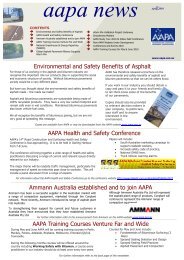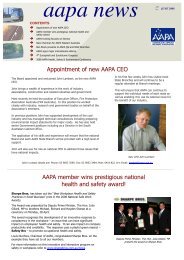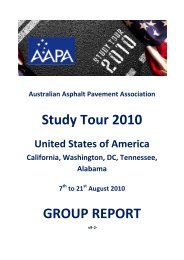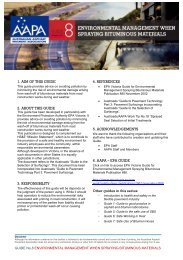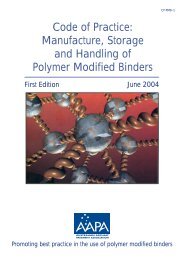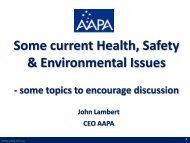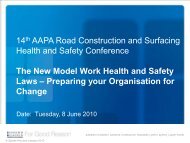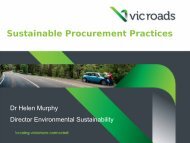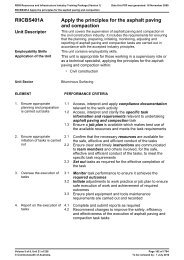Asphalt Review - Feb/March 2013 - Australian Asphalt Pavement ...
Asphalt Review - Feb/March 2013 - Australian Asphalt Pavement ...
Asphalt Review - Feb/March 2013 - Australian Asphalt Pavement ...
You also want an ePaper? Increase the reach of your titles
YUMPU automatically turns print PDFs into web optimized ePapers that Google loves.
ASPHALT REVIEW<br />
Roadwork Safety –<br />
Innovation and<br />
Future Directions<br />
The following paper is an abridged version of a presentation to AAPA’s 15th Road Construction<br />
and Surfacing Health and Safety Conference, in Melbourne during 2012. It highlights the<br />
experience of Michael Rose in roadwork safety in Victoria; however, the information contained<br />
in it is relevant across the whole of Australia. In particular it highlights the hierarchy of controls.<br />
This recognises that the behaviour of roadworkers and passing motorists is the primary risk on<br />
worksites. Physical separation (elimination of the risk) is therefore the most effective strategy and<br />
is top of the hierarchy of control.<br />
By Michael Rose CFSIA RSP Aust, Manager Project Safety, VicRoads Major Projects.<br />
Introduction – evolution and innovation<br />
of safety controls at VicRoads<br />
This paper provides an overview of the evolution and innovation in<br />
roadwork safety at VicRoads over the past decade, and highlights the<br />
current safety challenges still facing our industry.<br />
Prior to the introduction of the Worksite Safety–Traffic Management<br />
Code of Practice (2004 version) there were eight fatalities reported<br />
in Victoria for works on or adjacent to traffic over a 26-month period,<br />
including three on VicRoads works. There have been no fatalities since<br />
the Code was introduced on VicRoads major projects.<br />
The development of the hierarchy of safety controls for worksite<br />
traffic management and the classification of work on or adjacent to<br />
roads used by traffic as high risk work under Occupational Health<br />
and Safety (OHS) legislation for all classes of road have been major<br />
contributing factors to the safety improvements. Despite this good work<br />
we have not yet achieved zero injuries or fatalities in all areas.<br />
Major road projects are frequently faced with up to 16 classified<br />
high risk construction work activities. However, the activities involving<br />
mobile plant operation within work zones was demonstrated during<br />
2011 to be our highest risk area with at least five fatalities around<br />
Australia.<br />
The Hierarchy of Safety Controls for Roadwork<br />
The Hierarchy of Safety Controls for Worksite Traffic Management was<br />
first introduced by VicRoads in 2005 via the Worksite Safety–Traffic<br />
Management Code of Practice (2004 version). At the same time, the<br />
OHS Act 2004 was introduced mandating the hierarchy of controls<br />
approach through the defined concept of Ensuring Health and Safety<br />
(OHS Act, Section 20).<br />
The introduction of the OHS Regulations in 2007 further reinforced<br />
that works on or adjacent to roads used by traffic is a high risk activity<br />
for construction work. It also established the statutory obligation to<br />
eliminate the traffic hazard where reasonably practicable or reduce the<br />
risks by following the established hierarchy of safety controls.<br />
The hierarchy of controls may be described as:<br />
1. Elimination;<br />
2. Substitution;<br />
3. Isolation;<br />
4. Engineering;<br />
5. Administrative;<br />
6. Personal protective equipment; and<br />
7. A combination of controls<br />
The WorkSafe Test of Reasonably Practicable<br />
The OHS Act 2004 Section 20 requires hazards be eliminated, so far as<br />
reasonably practicable, or reduced via the hierarchy of safety controls,<br />
so far as is reasonably practicable. The WorkSafe test for practicability<br />
requires the following factors to be considered.<br />
• How likely is it that there will be some harm;<br />
• How serious could the consequences be;<br />
• What do, or should, you know about the hazard and ways of<br />
eliminating or reducing it<br />
• Are suitable ways to eliminate or reduce the hazard or risk available;<br />
and<br />
• How much will it cost to eliminate or reduce the hazard or risk (This<br />
is not a defence at law and needs to be balanced against the duty of<br />
care for workers with a presumption in favour of health and safety.<br />
Therefore cost is not as a credible reason against deployment).<br />
Evolution of practices in traffic<br />
management safety in Victoria<br />
The following describes evolved practices in traffic management<br />
safety in Victoria since 2006, using the hierarchy of traffic controls and<br />
commencing with the most effective and reliable controls:<br />
a. Elimination of Hazard - Road Closure to Eliminate the Traffic Hazard<br />
Full or partial road closure is the highest level control used. Road<br />
closures should be well communicated in advance to the public<br />
to reduce inconvenience. Road closures also facilitate increased<br />
productivity with reduction in construction times due to the removal of<br />
traffic and the unrestricted access provided.<br />
24 ROADS FEB/MARCH <strong>2013</strong>



